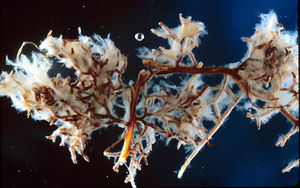Ectomycorrhizal Fungi: Difference between revisions
Jump to navigation
Jump to search
No edit summary |
No edit summary |
||
| Line 2: | Line 2: | ||
Ectomycorrhizal (ECM) fungi form symbiotic relationships with plant roots. Only about 2% of the plant species on earth form endomycorrhizal relationships, but therein exist some of the most environmentally and economically important species. [1] | Ectomycorrhizal (ECM) fungi form symbiotic relationships with plant roots. Only about 2% of the plant species on earth form endomycorrhizal relationships, but therein exist some of the most environmentally and economically important species. [1] | ||
==Structures== | |||
===Hartig net=== | |||
===Mantle=== | |||
===Extraradical hyphae=== | |||
===Fruiting bodies=== | |||
Revision as of 00:30, 9 May 2018

Ectomycorrhizal (ECM) fungi form symbiotic relationships with plant roots. Only about 2% of the plant species on earth form endomycorrhizal relationships, but therein exist some of the most environmentally and economically important species. [1]
Structures
Hartig net
Mantle
Extraradical hyphae
Fruiting bodies
References
[1] Tedersoo, Leho; May, Tom W.; Smith, Matthew E. (2010). "Ectomycorrhizal lifestyle in fungi: global diversity, distribution, and evolution of phylogenetic lineages" (PDF). Mycorrhiza. 20 (4): 217–263. doi:10.1007/s00572-009-0274-x. PMID 20191371.